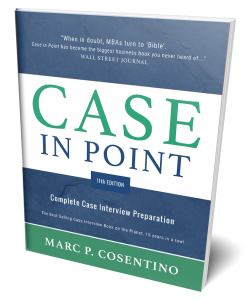A framework is a structure that helps you organize your thoughts and analyze the case in a logical manner. Often, you have to cut and paste from numerous frameworks to answer a single case question.
After years of development, testing and refinement Cosentino developed The Ivy Case System®.
The difference between a framework and a system is that a framework is really a tool, while a system is a process. Instead of memorizing 7 individual frameworks and then trying to decide which one(s) to apply, you learn the system, which already has the tools built in.
The Ivy Case System is a 2-part system made up of 5 easy steps to get you going and 4 popular case scenarios, each equipped with a collection of ideas and questions that will help you structure the remainder of your response. If you follow through the outline given for each scenario, you can be confident that your response will be logical and cohesive.
The First 5 Steps
- Summarize the question
- Verify the client’s objective
- Ask clarifying questions about the company, industry, market, products and competition.
- Layout your structure
- State a hypothesis
For more detail on the First 5 Steps see: Case Commandments.
The 4 Most Popular Case Scenarios
Business cases traditionally have focused on either business strategy or business operations. However, with today’s more complex cases, candidates are getting cases that cover both categories and multiple scenarios. The four most popular case are: profit and loss, entering a new market, pricing and growth.
Step 1: Analyze the company. You should ask, why do they want to enter the market? How big is the company? What were its revenues and profits for the last three years. Ask about its product mix, distribution channels customer segmentation and what constitutes success to them? Is it a particular market share or revenues number?
Step 2: Investigate the current market to determine whether entering the market would make good business sense.Entering a New Market – Things you need to be thinking about.
- Who is our competition?
- What size market share does each competitor have?
- How do their products/services compare to ours?
- Are there any barriers to entry? Such as government regulations, access to distribution channels, capital requirements.
- Have there been any changes in the market; new technology, mergers or new players?
Step 2: If we decide to enter the market, what is the best way?
There are three main ways to enter a market.
- Start from scratch
- Acquire an existing business
- Form a joint venture
Analyze the pros and cons of each. This is sometimes called cost-benefit analysis. You can use this whenever you are trying to decide whether or not to proceed with a decision.
For more on the 4 Case Scenarios read Case in Point.

